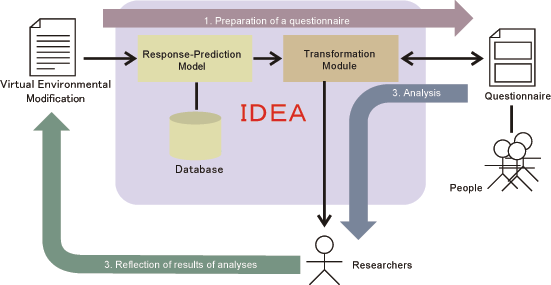Approaches
We develop IDEA (Interactive Device
between Environments and Artifacts) as a tool to analyze
the relationships between environmental consciousness and environmental quality.
In our current plan, IDEA consists
of the following three major components:
- Response Prediction Model
- Environmental Database
- Transformation Module
Our ultimate goal is to provide IDEA as a packaged tool that includes the framework
of IDEA and the manual on methods to customize the
model to specific environment and users.
 |
| What is the Response Prediction Model? |
|
The response prediction model is
an integrated model or a set of models that predicts the changes in parameters
of certain environmental elements in response to various environmental
impact scenarios.
A possible scenario may be clear-cutting certain areas of the forests
in the watershed. The model will provide the prediction results as changes
in the values of a collection of variables, for example, as an increase
in nitrate concentration in stream water from 1mg/L to 5mg/L, an decrease
in pH of the stream water from 7 to 5.5, and tree biomass from 300 ton/ha
to 50 ton/ha.
In this project, our Response Prediction Model assumes its use in forest-river-lake
environment of the study area. In our current plan, the construction of
the model for this multi-ecosystem environment may base on an integration
of several existing models for each specific ecosystem developed by other
research groups.
The model output will be supplied in quantitative forms. These output
values will then be fed to the Transformation Module, where the output
data are translated into more narrative expressions that describe the environmental
changes to be used in the survey questionnaires. |
| What is the Environmental Database? |
|
Environmental database is a collection
of natural-scientific and sociological data about the subject environment
to localize the Response Prediction Model.
The data are used to parameterize the skeletal model so it fits to the
characteristics of the specific environment. Natural-scientific data may
include physical, chemical, or biological data of the subject environment
at different times of the history collected through long-term monitoring
and laboratory analyses, such as surface water chemistry, forest tree biomass,
and animal species composition, etc. Social data may be those collected
from some official documents such as land-use history in the subject environment. |
| What is Transformation Module? |
|
Transformation module is an component of IDEA to
aid the users to translate a set of quantitative environmental attributes
into descriptive words that people often use to describe the quality of
the environment, and vice versa.
With Transformation Module, the user can
convert environmental qualities into verbal expressions of people's environmental
consciousness. For example, a set of parameter values, "water temperature
= x degree C, electric conductivity = y mS/s, and chlorophyll a concentration
= z mg/L " of a lake water may be translated into a description, "green-colored
water with a mat of blue green algae."
The module contains Object Map and the list
of conditions for translation mentioned above. Object
Map is a map of objects that people identify as important entities
of the concerned environment, connected to each other if any relationships
exist between them. |
| How does IDEA work? |
|
In our current plan, IDEA will be used in the following steps.
- Conduct Interest Questionnaire Survey to
investigate the people's areas of interest in the selected environment.
Based on the Interest QS results, select the environmental elements to
manipulate in the virtual environmental impact scenarios.
- Run the Response Prediction Model and predict the consequences of the
impacts to the selected environmental elements.
- Using Transformation Module,
convert the quantitative environmental elements into narrative forms
to
- Conduct Main Questionnaire Survey (Main QS) to
ask people's preferences over these scenarios.
- From the results in 3, estimate the environmental elements that are
common in the scenarios that people responded most sensitively.
- Run the Response Prediction Model with new set of scenarios, in which
the environmental elements that were identified in 4 are mainly manipulated.
- Conduct Main QS again with the new set
of response prediction results, which were converted to narrative expressions
through Transformation Module.
- Repeat 5 to 7 until certain environmental elements are identified as
the ones that people were most concerned about.
IDEA is still in the early stage of development.
The structure and functionality of IDEA may
evolve and change adaptively as we gain more knowledge and as the model
undergoes trials and errors throughout the developmental process. |
| How is IDEA developed? |
|
Environmental Valuation Project members divide into three groups (some of them are involved
in more than two groups). Each group takes charges of the development of IDEA components.
- IDEA Development Team: designs the overall
framework and the functionality of IDEA.
Establishes the procedures of using IDEA. Develops Transformation
Module. Coordinates the activities of other teams so the works by
each team fit the framework of IDEA flawlessly in the final integration.
- Response Prediction Model Team: constructs environmental
database and Response
Prediction Model through
collection of field data. Cooperate with IDEA Development Team in developing
the methods to convert quantitative environmental parameters to narrative
expressions in Transformation Module.
- Social Survey Team: designs survey questionnaire
for Interest QS and main
QS. Develop the methods for analyzing and feeding sociological data
to the other parts of IDEA in usable forms.
|
|


